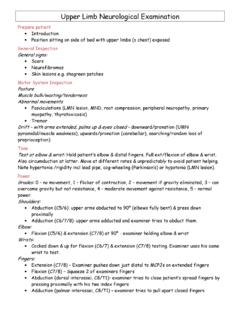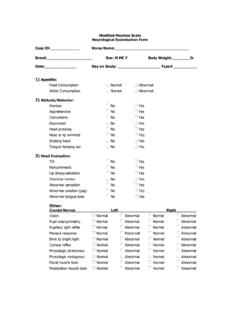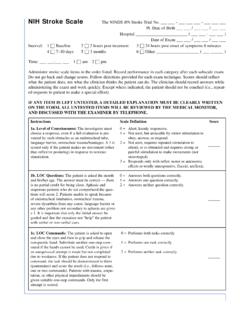Transcription of Do You See What I See? A Focused NIHSS …
1 1 Gail Schramek MSN, NP-C, CNRN Friday, September 20, 2013 Crystal Mountain Resort and Spa Do You See What I See? A Focused NIHSS Assessment, An Assessment Made Easy 2 Objectives Define the NIHSS Explain the purpose of the NIHSS Define the key areas of assessment of the NIHSS Describe the practical implementation of the NIHSS What is the NIHSS ? 3 The National Institutes of Health Stroke Scale ( NIHSS ) is a systematic assessment tool that provides a quantitative measure of stroke-related neurologic deficit. Clinical stroke assessment tool to evaluate and document neurological status in acute stroke patients. Assessment Score 4 Easy to report; range from 0-42 Gives other care providers an idea of patient s condition by a number 0 = normal <4 mild 5-10 mild-moderate 10-20 moderate >20 severe Takes 5-8 minutes Exam may be replicated 5 Purpose of the NIHSS Brief, quick, directed neurological exam Reliably predicts outcome Excellent method to track changes over time Symptomatic hemorrhage (+ 4 points) Clinical improvement (- 4 points) Standardized method of documentation Communication Research 6 General Rules: Be Consistent Follow methods/ instructions exactly Perform score in the correct order All items must be scored.
2 (Use a scoring sheet if necessary) Do not coach the patient: score the patient s first effort; not the best effort Score what the patient does; not what you think patient can do. Areas of Assessment 7 Level of Consciousness Items , b, c Vision and Eye Movement Items 2 & 3 Movement and Coordination Items 4,5,6 & 7 Sensation Items 8 & 11 Speech and Language Function Items 9 & 10 Areas of Assessment: 1a. Level of consciousness 8 ALERT (0) Keenly responsive Aware of self and environment DROWSY /LETHARGIC (1): Not alert Less interest in the environment Arousable by minor stimulation to obey, answer, or respond Areas of Assessment: 1a.
3 Level of consciousness 9 STUPOR/ OBTUNDED (2): Not alert. Requires repeated stimulation. May need painful or strong stimulation to make COMA (3): Responds only with reflex motor or autonomic effects. Totally unresponsive, flaccid, and areflexic No localization to noxious stimulus Areas of Assessment: 1a. Level of consciousness TIPS Obstacles such as an endotracheal tube, language barrier, orotracheal trauma/ bandages - You MUST assign a score EXCEPTION to the first effort rule 10 11 1b. Level of consciousness: Questions Age and Month of the year 0 = Answers both questions correctly 1 = Answers one question correctly. 2 = Answers neither question correctly SCORE THE FIRST ANSWER.
4 NO CUES ALLOWED. 1b. Level of consciousness: Questions TIPS Other orientation questions are not asked as this is a standardized test. Aphasic and stuporous patients who do not comprehend the questions will score 2. Patients unable to speak because of endotracheal intubation, orotracheal trauma, severe dysarthria from any cause, language barrier, or any other problem not secondary to aphasia are given 1.. 12 13 Close your eyes and open them Make a fist with your hand 0 = Performs both tasks correctly 1 = Performs one task correctly 2 = Performs neither task correctly 1c. Level of consciousness: Commands 1c. Level of consciousness: Commands TIPS 14 MIME with making a fist while asking the question You CAN repeat the question ONCE If language barrier; you ARE ALLOWED to use an interpreter Receptive aphasia: 2 if not performed correctly If patient makes a conscious effort but cannot perform the task due to weakness, GIVE CREDIT 15 0 = Normal 1 = Partial gaze palsy; gaze is abnormal in one or both eyes, but forced deviation or total gaze paresis is not present 2 = Forced deviation, or total gaze paresis not overcome by the oculocephalic maneuver 2.
5 Best Gaze We only test HORIZONTAL gaze 16 If a patient has an isolated peripheral nerve paresis (CN III, IV or VI), score a 1. Patients with ocular trauma, bandages, pre-existing blindness, or other disorder of visual acuity or fields should be tested with reflexive movements. Aphasic patient: you can ALWAYS test gaze. COMA: you may need oculocephalics. 2. Best Gaze TIPS 17 3. Visual Fields Tested by confrontation: ONE EYE AT A TIME Finger counting finger movements Visual threat 0 = No visual loss 1 = Partial hemianopia 2 = Complete hemianopia 3 = Bilateral hemianopia (blind including cortical blindness) 18 Blind in one eye: score the other eye Blind in both eyes: score 3 Aphasia: test using threat 3.
6 Visual Fields TIPS 4. Facial Palsy 19 Ask patient to show teeth / smile, raise eyebrows, squeeze eyes shut 0 = Normal symmetrical movements 1 = Minor paralysis (flattened nasolabial fold, asymmetry on smiling) 2 = Partial paralysis (total or near-total paralysis of lower face) 3 = Complete paralysis of one or both sides (absence of facial movement in the upper and lower face) 20 If facial trauma/bandages, orotracheal tube, tape or other physical barriers obscure the face, these should be removed to the extent possible. Aphasic patient: test grimace. 4. Facial Palsy TIPS 4. Facial Palsy 21 5A and B: Motor arm: Right and Left Check ONE at a time; palms facing DOWN Count with fingers 0 = No drift; limb holds for full 10 seconds 1 = Drift; limb holds but drifts down before full 10 seconds; does not hit bed or other support 2 = Some effort against gravity; limb cannot get to or maintain (if cued) 90 (or 45) degrees, drifts down to bed, but has some effort against gravity 3 = No effort against gravity; limb falls 4 = No movement UN = Amputation or joint fusion 22 23 Aphasic and confused patient may need coaxing or pantomime.
7 Initial dip of the limb is allowed, only score if limb drifts after a dip. Can be tested with patient sitting or supine Arthritis / joint pain: use your best judgement. 5A and B: Motor arm: Right and Left TIPS 24 5A and B: Motor arm: Right and Left TIPS 6A and B: Motor leg: Right and Left Elevate leg off bed for 5 seconds 0 = No drift; leg holds for full 5 seconds 1 = Drift; leg falls by the end of the 5-second period but does not hit bed 2 = Some effort against gravity; leg falls to bed by 5 seconds, but has some effort against gravity 3 = No effort against gravity; leg falls to bed immediately 4 = No movement UN = Amputation or joint fusion 25 26 If comatose: 5 and 6 are scored 4.
8 Reflex postural movements do not count. 6A and B: Motor leg: Right and Left TIPS 7. Limb Ataxia 27 Finger to nose and Heel to shin on both sides 0 = Absent 1 = Present in one limb 2 = Present in two limbs UN = Amputation or joint fusion 7. Limb Ataxia TIPS 28 Make sure this is done in the intact visual field. Ataxia out of proportion to weakness is scored. If patient cannot understand ( aphasic) or paralyzed limb: score 0. Comatose patient: score 0. CANNOT TEST: CANNOT SCORE Testing Limb Ataxia 29 Ataxia Video 30 8. Senosry 31 Test with a pin on the proximal extremity 0 = Normal; no sensory loss 1 = Mild-to-moderate sensory loss; patient feels pinprick is less sharp or is dull on the affected side; or there is a loss of superficial pain with pinprick, but patient is aware of being touched 2 = Severe to total sensory loss; patient is not aware of being touched in the face, arm, and leg Score of 2 is very rare: there has to be complete sensory loss!
9 8. Sensory TIPS 32 Compare sides: don t ask sharp or dull. Score bare skin: not through clothing. Aphasic patient: test withdrawal of limb from noxious stimulus. Comatose patients: automatically scored 2. Brainstem stroke: bilateral loss of sensation: score 2. 9. Best Language 33 Comprehension based on exam Objective tests: cookie jar picture, read sentences, naming objects 0 = No aphasia, normal 1 = Mild to moderate aphasia 2 = Severe aphasia 3 = Mute, global aphasia. No usable speech or auditory comprehension 9. Best Language TIPS 34 Coma or stupor: score 3 Visual impaired: hold objects in the hand Cultural implications 9.
10 Best Language 35 10. Dysarthria 36 Evaluate Speech Clarity by asking patient to repeat listed words 0 = Normal articulation 1 = Mild-to-moderate dysarthria; patient slurs at least some words 2 = Severe dysarthria; patient's speech is so slurred as to be unintelligible or is mute UN = Intubated or other physical barrier Language Testing 37 38 Unresponsive or comatose patient: score 2. If patient is mute score 2. If difficulty understanding due to a physical barrier such as no teeth, score 1. 10. Dysarthria TIPS 11. Extinction and Inattention 39 Use Information from prior testing to identify neglect. Use Double simultaneous stimuli testing. 0 = No abnormality 1 = Partial Neglect, inattention or extinction to bilateral simultaneous stimulation 2 = Compete Neglect, does not recognize own hand or orients to only one side of space 40 Blind person with intact sensory attention: score normal Aphasia: use best judgement 11.





